NCERT Exemplar Solutions: Coal & Petroleum | Science Class 8 PDF Download
Multiple Choice Questions
Q.1. Various materials which are obtained from nature are called natural resources. Which of the following is not a natural resource?
(a) minerals
(b) water
(c) soil
(d) plastic
Ans: d
Explanation:
Minerals, water and soil are natural resources whereas plastic is a man-made substance.
Q.2. Air is a natural resource and cannot be exhausted by human activities. It is known as an inexhaustible natural resource. Which of the following is another inexhaustible natural resource?
(a) coal
(b) petroleum
(c) sun-light
(d) minerals
Ans: c
Explanation:
Caol, petroleum and minerals are non-renewable sources of energy, which can get exhausted whereas sunlight is a renewable resource.
Q.3. Which of the following is a pair of exhaustible natural resources?
(a) coal and soil
(b) air and sun-light
(c) water and petroleum
(d) wildlife and minerals
Ans: d
Explanation:
Coal and Soil, air and sunlight, water and petroleum. All these natural resources cannot be exhausted by human consumption and other uses. Wildlife and minerals are exhaustible natural resources, which are available in limited quantities and will be exhausted as a result of continuous use.
Q.4. Coal is processed in industries to get some useful products. Which of the following is not obtained from coal?
(a) coke
(b) coal tar
(c) coal gas
(d) CNG
Ans: d
Explanation:
CNG is compressed natural gas which is made by compressing the natural gas. CNG is a petroleum product whereas coke, coal tar and coal gas are obtained from coal.
Q.5. Exhaustible natural resources are:
(a) unlimited in quantity.
(b) not dependent on nature.
(c) limited in quantity.
(d) not exhausted by human activities.
Ans: c
Explanation:
Exhaustible natural resources are limited resources, which are available in limited quantities and are going to be exhausted by continuous human use. Wildlife, petroleum, water and minerals are examples of Exhaustible natural resources.
Q.6. Fossil fuels are obtained from:
(a) remains of non-living materials.
(b) dead remains of birds only.
(c) dead remains of insects only.
(d) dead remains of living organisms.
Ans: d
Explanation:
Fossil fuels are obtained millions of years ago remains of dead remains of living organisms. Get buried under the earth.
Q.7. Coal is formed from the remains of
(a) vegetation only
(b) animals only
(c) both vegetation and animals
(d) neither vegetation nor animals
Ans: a
Explanation:
Coal is a fossil fuel formed from the remains of prehistoric plants or animals. The formation of coal occurs over millions of years via a process known as carbonation.
Q.8. Which substance is formed by the carbonisation of dead vegetation?.
(a) coal
(b) coke
(c) coal gas
(d) coal tar
Ans: a
Explanation:
The formation of coal occurs over millions of years via a process known as carbonation. In this process, dead vegetation is converted into carbon-rich coal under very high temperature and pressure.
Q.9. Naphthalene balls are obtained from coal tar and are used as:
(a) mosquito repellant
(b) honey bee repellant
(c) moth repellant
(d) snake repellant
Ans: c
Explanation:
Naphthalene balls are chemical pesticide and deodorant, the characteristic smell of naphthalene makes the insects and moth run away from naphthalene stored under clothes etc.
Q.10. Which of the following is not a constituent of petroleum?
(a) paraffin wax
(b) lubricating oil
(c) petrol
(d) coke
Ans: d
Explanation:
Coke is not a constituent of petroleum. It is almost a pure form of carbon.
Q.11. Petroleum was formed from organisms:
(a) living on the land
(b) living on the plants
(c) living in the sea
(d) living on the rocks
Ans: c
Explanation:
Petroleum was formed from organisms living in the sea. As these organisms died, their bodies settled down at the bottom of the sea and got covered with layers of sand and clay. Over millions of years, absence of air, high temperature and high pressure transformed the dead organisms into petroleum and natural gas.
Q.12. Choose the incorrect statement from the following:
(a) It is difficult to transport natural gas through pipes.
(b) The disadvantage of natural gas is that it can not be used directly for burning in homes.
(c) Natural gas is stored under high pressure as compressed natural gas.
(d) Natural gas cannot be used for power generation.
Ans: a
Explanation:
Natural gas is a naturally occurring hydrocarbon gas, which is extracted from the petroleum deposits deep beneath the earth. It is a highly flammable gas, therefore, it is difficult to transport through pipes.
Very Short Answer Questions
Q.1. You are provided with a mixture of petroleum and water. Can you suggest a method to separate the two?
Ans: Decantation is the method used to separate a mixture of petroleum and water.
Q.2. What does CNG stand for and why is it considered to be a better fuel than petrol?
Ans: CNG stands for compressed natural gas.
CNG is considered to be a better fuel than petrol because:
- CNG burns with no smoke.
- It does not cause air pollution.
- CNG does not produce any poisonous gas.
Q.3. Name the petroleum product used as fuel for stoves, lamps and jet aircraft.
Ans: Kerosene is the petroleum product used as fuel for stoves, lamps and jet aircrafts.
Q.4. Fill in the blanks in the following sentences.
(a) Coal is one of the ________ used to cook food.
(b) When heated in air, coal burns and produces mainly ________ gas.
(c) Coal tar is a black, thick ________ with an ________ smell.
(d) Petroleum, ________ and ________ are fossil fuels.
(e) Forests and coal are ________ natural resources.
Ans:
(a) Coal is one of the fuels used to cook food.
(b) When heated in air, coal burns and produces mainly Carbon-di-oxide gas.
(c) Coal tar is a black, thick liquid with an unpleasant smell.
(d) Petroleum, Coal and natural gas are fossil fuels.
(e) Forests and coal are exhaustible natural resources.
Q.4. The underlined words in the following sentences have been jumbled up. Write them in their correct form.
(a) Loca is obtained from mines.
(b) Umpetlore is a fossil fuel.
(c) Rineryfe is a place where various fractions of petroleum are separated.
(d) Keenrose is a fuel used in jet crafts.
(e) Nutsgilh is an example of inexhaustible natural resources.
Ans:
(a) coal
(b) petroleum
(c) refinery
(d) kerosene
(e) sunlight
Q.5. Fill in the blanks.
(a) The slow process of conversion of dead vegetation into coal is called__________.
(b) Coal and petroleum are formed from the dead remains of organisms and are known as __________.
(c) The black thick liquid with __________ smell is known as coal tar.
(d) During the processing of coal to get coke, coal tar and __________ are also obtained
(e) The process of separating the various constituents of petroleum is known as __________.
(f) Excessive burning of fossil fuels is a major cause of __________.
Ans:
(a) The slow process of conversion of dead vegetation into coal is called carbonisation.
(b) Coal and petroleum are formed from the dead remains of organisms and are known as fossil fuels.
(c) The black thick liquid with an unpleasant smell is known as coal tar.
(d) During the processing of coal to get a coke, coal tar and coal gas are also obtained.
(e) The process of separating the various constituents of petroleum is known as refining.
(f) Excessive burning of fossil fuels is a major cause of air pollution.
Q.6. Write True/False against the following statements.
(a) Oxygen is an exhaustible natural resource.
(b) Resources which are present in unlimited quantity in nature are called exhaustible natural resources.
(c) Wildlife is an exhaustible natural resource.
(d) Under high temperature and pressure, dead plants get slowly converted to coal.
(e) CNG is less polluting fuel than petrol and diesel.
Ans:
a) False
Explanation: Oxygen is not an exhaustible natural resource.
b) False,
Explanation: Resources which are present in unlimited quantity in nature are called inexhaustible natural resources.
(c) True,
(d) True,
(e) True.
Short Answer Questions
Q.7. Sunlight and air are inexhaustible natural resources. Comment.
Ans: Sunlight and air are present in unlimited quantity in nature and are not likely to be exhausted by human activities or by any other means. Hence Sunlight and the air are inexhaustible natural resources.
Q.8. Some natural resources are given in a box. Classify them into the exhaustible and inexhaustible natural resources.
Air, Coal, Natural gas, Sunlight, Petroleum, Minerals, Forests and Oxygen.
Ans:
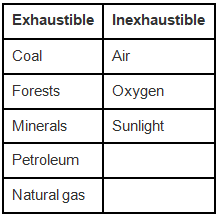
Q.9. Write two important uses of coke.
Ans: Important uses of coke are as follows:
- Coke is used in the manufacture of steel.
- Coke is used as a reducing agent in the extraction of metal from its ore.
Q.10. Write the characteristics and some important uses of coal.
Ans:
- Characteristics of coal.
- It is a fossil fuel.
- It is Combustible.
- It is as hard as stone and is black in colour.
- When it is burned in the air it releases CO2.
- Uses of Coal
- Coal is one of the fuels used to cook food.
- Coal is also used as fuel in various industries.
- It is also used in thermal power plants to produce electricity.
- Earlier, it was used in railway engines to produce steam to run the engine.
Q.11. Look at Figure where petroleum and natural gas deposits are shown. Why do we find the oil layer above the water layer?
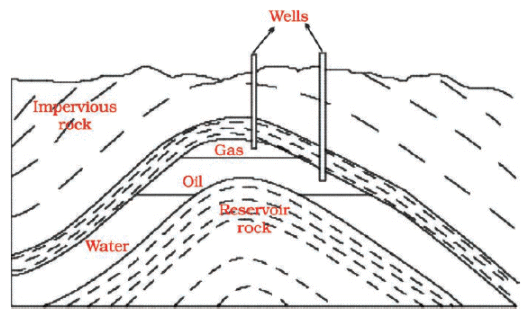
Ans: Oil is found above the water layer because oil is lighter than water, hence oil floats above the water layer.
Q.12. Fill in the blanks and complete the story.
About 300 million years ago the earth had dense ________ in low lying wetland areas. Due to natural processes, like ______, these forests got burried under the ________. As more ________ deposited over them, they were compressed. The ________ also rose as they sank deeper and deeper. Under high ________ and high ________, dead plants got slowly converted into coal.
Ans:
About 300 million years ago the earth had dense forests in low lying wetland areas. Due to natural processes, like floods, these forests got buried under the soil. As more soil deposited over them, they were compressed. The temperature also rose as they sank deeper and deeper. Under high pressure and high temperature, dead plants got slowly converted into coal.
Q.13. Match the items given in Column I with the items of Column II.
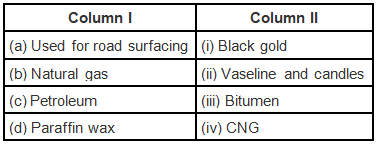
Ans:
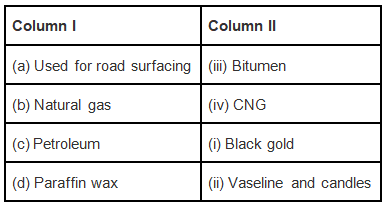
Long Answer Questions
Q.1. Name the products obtained and their uses when coal is processed in industry.
Ans: Coke, coal tar and coal gas are the products obtained during the process of coal in the industries.
Application of these products are:
- Coal gas is used as fuel.
- Coke is used as a reducing agent in the extraction of metals.
- Coal tar is used as starting material for manufacturing various substances such as synthetic dyes, drugs, explosives, perfumes, paints etc.
Q.2. We say fossil fuels will last only for a few hundred years. Comment.
Ans: Fossils fuels take millions of years to get converted into these fuels. Formation of fossil fuels requires specific conditions and it doesn’t happen quite often. Therefore, their limited stock will last only for a few hundred years.
Q.3. We read in newspapers that burning of fuels is a major cause of global warming. Explain why?
Ans: Burning of fuels leads to release of carbon-di-oxide, carbon-monoxide and SO2 gases. These are the greenhouses gases that not only increases air pollution but also contribute to global warming by trapping radiations from the sun.
Q.4. While driving what are the tips we must follow to save petrol/ diesel/natural gas?
Ans: Steps to follow while driving to save petrol/ diesel/natural gas are:
- Ensure correct tyre pressure.
- Ensure regular maintenance of the vehicle.
- Drive at a constant and moderate speed as far as possible.
- Switch off the engine at traffic lights or at a place where you have to wait.
Q.5. Imagine that all the exhaustible natural resources are exhausted by human activities. Do you think the survival of living beings would be possible.? If yes, why?, If not, why not?
Ans: If all the exhaustible natural resources are exhausted by human activities then survival of living beings would be impossible. Fossil fuels are a very important source of energy for us today. On burning fossil fuel, it gives off heat and light. The heat produced can be used to cook food or to run engines such as automobile engines. It is also used to generate electricity as in powerhouse where the most common fuel used is coal.
Q.6. Why petrol is an exhaustible natural resource, whereas sunlight is not? Explain.
Ans: Petrol is a fossil fuel, which is produced after years of decomposition of buried and plants deep down the earth. For producing petrol we need millions of years. If we use petrol higher than the requirement, it will get exhausted. Whereas the sun is a continuous and unlimited source of energy. Sun is a renewable resource of energy which will not get exhausted.
Q.7. Write some important uses of the various constituents of petroleum.
Ans: Constituents of Petroleum are petroleum gas, petrol, diesel, kerosene, lubricating oil, paraffin wax and bitumen.
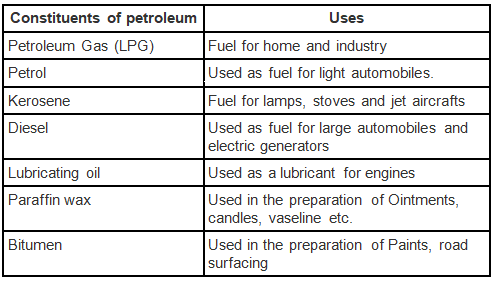
Q.8. Coal reserves are said to be enough to last for another hundred years. Do you think we need to worry in such a case? Why or why not?
Ans: Coal reserves are said to be enough to last for another hundred years. Because there will be no availability of coal after the exhaust of existing coal resource. To produce coal it will take millions of years. Dead organisms should be buried in the earth and it should decompose in the absence of oxygen. For all these process coal formation needs millions of years.
Q.9. What steps would you suggest for the judicious use of fossil fuels?
Ans: Steps to take for the judicious use of fossil fuels
- Use solar energy wherever possible.
- Use fossil fuels only when it is required.
- We can use natural gas in place of fossil fuels
- Switch off automobile engine while standing in traffic.
- Use Alternate sources of energy like, solar, wind and biomass should be used in place of fossil fuels.
Q.10. Complete the crossword Figure with the help of the clues:

Across
1. Fuels obtained form dead remains of living organisms. (6,5)
2. A process by which the various constituents of petroleum are separated. (8)
3. A porous black substance obtained form of coal. (4)
4. Another name for motor fuel. (6)
Down
5. The substance obtained by carbonisation. (4)
6. Fuel for heavy motor vehicles. (6)
7. A petroleum product used for road surfacing. (7)
8. Dead remains of sea animals got converted into it. (9)
Ans:

|
90 videos|273 docs|44 tests
|
FAQs on NCERT Exemplar Solutions: Coal & Petroleum - Science Class 8
| 1. What is coal? |  |
| 2. How is coal formed? |  |
| 3. What are the types of coal? |  |
| 4. How is coal used as a source of energy? |  |
| 5. What are the environmental impacts of coal usage? |  |



















